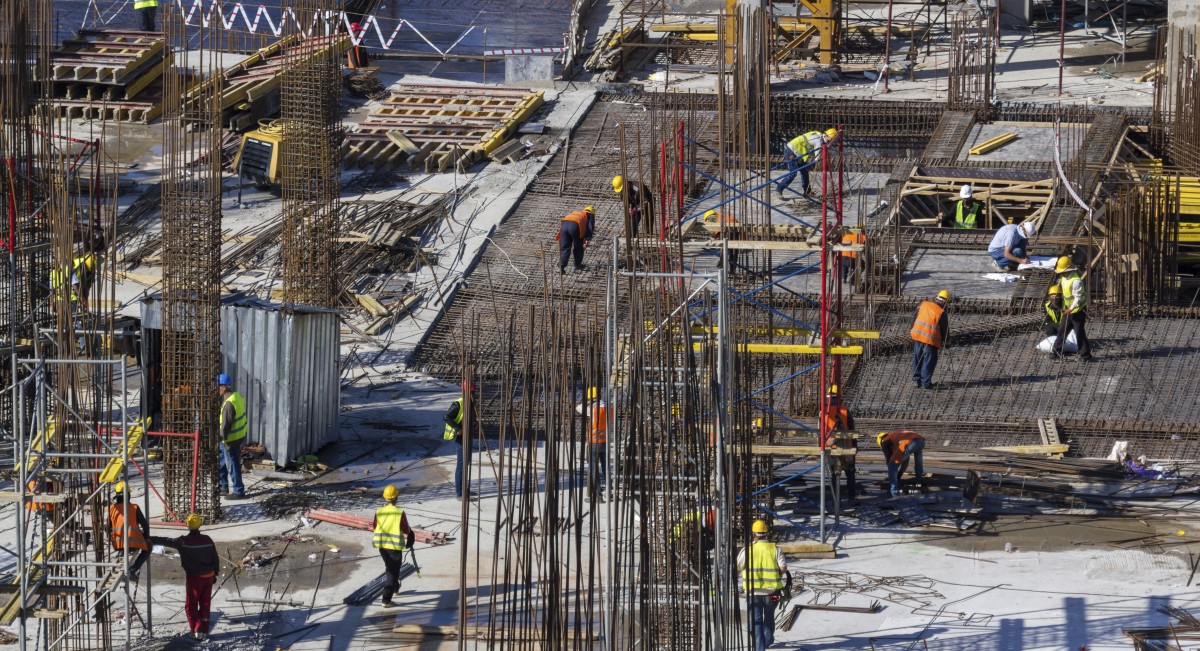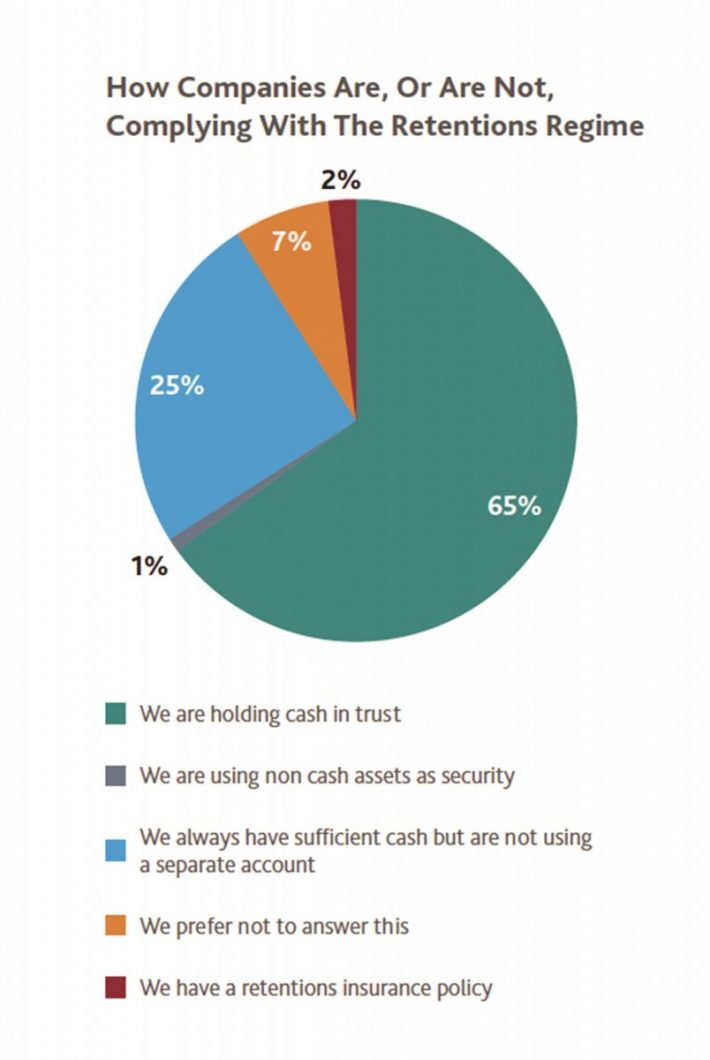RETENTION REALITIES
20 Nov 2019, Industry News, News

BDO’s 2019 Construction Survey Report revealed some of the challenges facing the construction industry. This issue we look at the realities of who is adhering to retention rules, and what subcontractors can do if someone isn’t
Retentions are one of the most contentious subjects in commercial construction, especially in the wake of recent high-profile companies leaving subcontractors out of pocket when put into liquidation. This is despite regulations surrounding retentions coming into effect more than two years ago.
When retentions go bad
From the client’s perspective, retentions are intended to ensure the contractor and subcontractor complete the work to the agreed standard. From the subcontractor’s perspective, the withheld retention can represent all of the profit they stand to make from the job. When everything goes to plan, this approach can work well, but when a head contractor goes bust, that money can be lost if the retentions have not been set aside properly.
Despite changes to the Construction Contracts Act in early 2017 to protect retention payments, several subcontractors are still unpaid or embroiled in lengthy legal battles after recent construction company collapses.
What is meant to happen?
Under amendments made to the Construction Contract Act in early 2017, retentions are meant to be held ‘on trust’. According to BDO’s report, what ‘on trust’ means specifically is not well defined by the Act. Crucially, it does not require money to be held in a separate account.
BDO’s report notes that “while the intermingling of funds is allowed under the Act, this is risky and does not guarantee that the funds are held on trust. Instead, best practice is to hold the retention monies in a specific trust account at the bank, for example labelled ‘Construction Retentions Trust Account’. This ensures that, in a receivership or liquidation situation, it is very clear that the funds are held in trust and cannot be used for any other purpose”.
At the other end of the scale, allowing the retentions money to be used as general operating capital could be considered ‘worst practice’ and would not be compliant. However, a lack of penalties, understanding and/or “desire to rock the boat” appears to contribute to no contractors taking remedial action.
Current levels of compliance
According to BDO’s report, 93% of respondents (who responded to the BDO survey, who had retentions payable) said they are complying with the retentions regime. Of these, 65% are following ‘best practice’ – holding cash in a separate account in trust – with 25% having sufficient cash are but not using a separate account.
Of the remaining 10%, 7% of respondents said they ‘preferred not to answer’, which BDO believed is most likely to mean “we aren’t complying”. The Ministry of Business Innovation and employment (MBIE) estimates that subcontractors write off between $7 million and $16 million in retentions each year.
Onus on the subbies
While those who hold retentions are meant to hold the money separately, in a way that that money cannot be used for other purposes, the onus for checking whether this is done falls to the subcontractor.
BDO was surprised to learn how few subcontractors actively inspect their head contractor’s trust records.
“In our 2018 survey, we asked how many [contractors] check to see if their retentions are held in trust by their customers. We were surprised by the level of inaction as, given most of the profit in a job is locked up in retentions receivable, this is basic risk management. Despite a number of highprofile insolvencies across the industry and shortfalls of funds in trust, the number of those actively inspecting their head contractor’s trust records has only improved to 30% (+4% on last year),” stated the report.
Of the 30% who did check if their retentions were held appropriately, almost half found at least one client who was not holding their retentions properly. As BDO notes, “these customers are simply not complying with the law”.
Why are subbies not checking?
According to Nick Innes-Jones, who co-authored the BDO review, there is a lack of understanding on subcontractor’s part about the retention inspection process.
“Our view, from having had discussions with industry participants in the construction industry, is that many simply don’t really know what to ask for,” said Innes-Jones. “And, if they do ask, they’re not sure whether the explanation or evidence they receive is sufficient.”
When asked what subbies are doing when they find a head contractor is not holding their retentions in accordance with the act, Innes said: “our sense is that they are not taking further action but are simply tolerating it. And it’s worth noting that some have indicated that the lack of penalties in the Act is a large factor for non-compliance.”
Graham Burke, President of the Specialist Trade Contractors Federation (STCF), echoed these comments.
“Subcontractors often don’t ask because they don’t want to rock the boat,” said Burke. “I don’t know of any subcontractors who have taken any action when they’ve found retentions are not being held properly, again, because they don’t want to rock the boat.”
What’s next?
Building and Construction Minister Jenny Salesa is currently considering changes to how retentions are held and an announcement is expected soon.
Burke, who recently made a submission to the Minister on behalf of the STCF, said the submission “focused on five points that we think would make the retentions regime stronger, without introducing undue levels of compliance costs”.
In summary, the STCF recommended that:
- Retentions must be held in an account used only for retentions.
- The holder of retentions must send regular updates to the subcontractor about how much is held in trust for them in their retention account.
- In the event of company failure, the liquidator automatically becomes distributor of retentions (rather than needing to apply to the courts).
- In the event of company failure, the liquidator is able to charge their fee, not to exceed 10%, which should be taken from the retentions fund (rather than needing to apply to the courts).
- Regulation should set penalties and there should be a body that can prosecute any breaches.
Burke also noted that these changes would only be one piece of the puzzle.
“Fixing the retentions regime is necessary, but it’s worth noting that this is part of improving construction contracting as a whole,” said Burke.
“The recent implementation of the government procurement rules is a good start to getting better contracts, a better fit between the contractor and the job required, a better balance of risk between the parties and, therefore, fewer construction company collapses and consequently fewer losses of subcontractors’ retentions.”
Register to earn LBP Points Sign in




